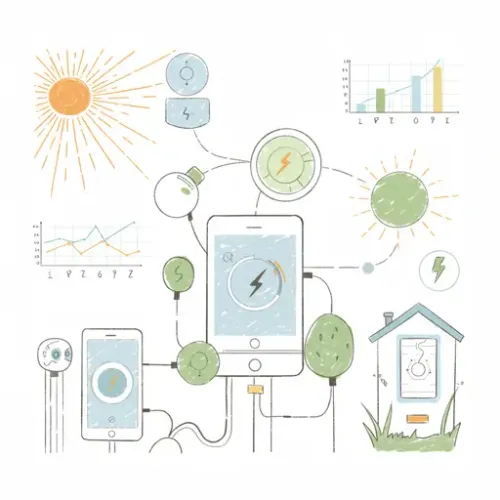Mastering Home Assistant's Energy Dashboard: Unlocking Comprehensive Energy Insights

NGC 224
DIY Smart Home Creator
Introduction
In an era of fluctuating energy costs and increasing environmental awareness, understanding and managing your home's energy footprint has become more critical than ever. Smart homes offer an unparalleled opportunity to gain granular insights into energy consumption and production. Home Assistant, with its robust and intuitive Energy Dashboard, provides a centralized, powerful, and privacy-focused solution to track every watt and kilowatt-hour. It's a transformative feature for anyone serious about optimizing their energy usage, reducing bills, and contributing to a more sustainable lifestyle.
The Power of the Home Assistant Energy Dashboard
Introduced in Home Assistant 2021.8, the Energy Dashboard is a dedicated section within the user interface meticulously designed to visualize your home's energy flow. It presents complex data in an easily digestible, graphical format, showcasing:
- Grid Consumption: How much energy you are importing from your utility provider.
- Solar Production: The total energy generated by your solar panels, including what's consumed directly and what's exported back to the grid.
- Battery Charge/Discharge: Insights into your home battery's contribution to energy management.
- Individual Device Consumption: The energy usage of specific appliances or circuits you choose to monitor.
- Estimated Costs: Financial impact based on your configured electricity tariffs, helping you understand your expenses in real-time.
This consolidated, real-time view empowers you to spot trends, identify energy-hungry devices (often called 'energy vampires'), and understand the true impact of your renewable energy sources or battery storage systems.
Essential Data Types for the Dashboard
For the Energy Dashboard to function optimally, it requires sensors that expose specific energy metrics. These sensors must adhere to Home Assistant's data model conventions, specifically possessing:
device_class: energy: For cumulative energy measurements, typically in kWh (kilowatt-hours).device_class: power: For instantaneous power measurements, typically in W (watts).state_class: total_increasing: Crucial for cumulative energy sensors that only increase (like a utility meter). The dashboard relies on this to calculate consumption over periods.state_class: measurement: For instantaneous power sensors.
The dashboard primarily consumes total_increasing energy sensors. If your devices only provide instantaneous `power` readings, Home Assistant offers built-in helper entities to convert this data into the required format.
Preparing Your Energy Data: Helper Entities
Often, raw sensor data needs to be processed or aggregated before it can be effectively used by the Energy Dashboard. Home Assistant's helper entities are invaluable for this:
1. The integration Sensor (Power to Energy Conversion)
If your device provides instantaneous power (W) but not cumulative energy (kWh), the `integration` sensor platform can convert power readings into energy over time. This is a common requirement for many smart plugs or DIY power monitors.
# configuration.yaml or a dedicated sensors.yaml file
sensor:
- platform: integration
source: sensor.your_power_meter # e.g., sensor.shelly_plug_s_power
name: Your Device Energy Consumption
unit_prefix: k # Converts W to kW, then to kWh
round: 2 # Rounds the output to two decimal places
This configuration creates a new sensor (e.g., sensor.your_device_energy_consumption) which accumulates energy, making it suitable for direct integration into the Energy Dashboard.
2. The utility_meter Sensor (Cycle Tracking and Tariffs)
The `utility_meter` helper is indispensable for tracking daily, weekly, monthly, or yearly energy usage, and for handling cost calculations based on varying tariffs. It effectively resets its value at the start of each defined cycle.
# configuration.yaml or a dedicated utility_meters.yaml file
utility_meter:
daily_grid_consumption:
source: sensor.total_grid_import_energy # Your main energy meter sensor
cycle: daily
peak_offpeak_consumption:
source: sensor.total_grid_import_energy
cycle: daily
tariffs:
- peak
- offpeak
For complex time-of-use (TOU) tariffs, you would create automations that switch between the defined tariffs (e.g., using the utility_meter.select_tariff service) based on your electricity provider's schedule.
Integrating Energy Devices and Sources
One of Home Assistant's greatest strengths is its extensive integration capabilities, allowing you to pull energy data from a vast array of devices:
- Smart Plugs/Switches with Energy Monitoring: Many Wi-Fi (e.g., Shelly Plug S, TP-Link Kasa HS110, or generic Tuya devices integrated with LocalTuya), Zigbee, or Z-Wave smart plugs offer built-in energy monitoring. Once integrated via their respective Home Assistant integrations (e.g., Shelly, Z-Wave JS, Zigbee2MQTT, LocalTuya), their energy sensors should automatically appear. Always ensure the `device_class` and `state_class` are correctly identified by the integration, or override them if necessary.
- Whole-Home Energy Monitors (CT Clamps): Devices like Shelly EM/3EM, IoTaWatt, or certain Emporia Vue models provide granular insights directly from your electrical panel. Their dedicated Home Assistant integrations will expose `energy` sensors for grid import/export, and often individual circuit monitoring.
- Solar Inverters: Integrations for popular solar inverter brands (e.g., Fronius, SolarEdge, Enphase, Solar-Log) expose vital solar production data. Look for sensors with `device_class: energy` and `state_class: total_increasing` representing your total produced energy.
- Battery Storage Systems: If you have a home battery system, its integration will typically provide sensors for battery charge and discharge, which can be configured within the dashboard to show energy flow to and from storage.
- Electric Vehicle (EV) Chargers: Smart EV chargers can contribute their consumption data directly, allowing you to track how much energy your vehicle is consuming.
Configuring the Energy Dashboard
Once your energy sensors are available and correctly configured (or converted via helpers), setting up the Energy Dashboard is straightforward:
- Navigate to
Settings->Energyin your Home Assistant UI. - Grid Consumption: Select your `total_increasing` sensor that represents energy consumed from the grid. You can also specify an optional `total_increasing` sensor for energy returned to the grid (solar export). If you have tariffs configured, apply them here.
- Solar Production: Choose your `total_increasing` sensor for the total solar energy produced by your system.
- Battery: If applicable, configure `total_increasing` sensors for energy put into the battery (charge) and energy taken out (discharge).
- Individual Devices: Add `total_increasing` energy sensors for specific appliances or groups of devices you wish to monitor separately. This helps pinpoint energy hogs and allows for more targeted optimization.
- Energy Costs: Define your electricity rates. You can set a fixed price per kWh or configure more complex peak/off-peak rates using the `utility_meter` tariffs you set up earlier.
Best Practices for a Reliable Energy Ecosystem
To ensure your energy data is accurate and your smart home ecosystem remains robust:
- Sensor Reliability: Ensure your physical energy sensors are stable and report consistently. Intermittent data can lead to gaps or inaccuracies in the dashboard. For critical measurements, wired connections are often more reliable than wireless.
- Correct
state_class: Always double-check that your cumulative energy sensors are explicitly `total_increasing`. If an integration doesn't set it correctly, you might need a template sensor to override it. utility_meterfor Daily Cycles: For any energy data you wish to track with daily, weekly, or monthly resets (and especially for cost calculations), always route it through a `utility_meter` helper. This ensures correct aggregation and resets.- Persistent State: While the `recorder` integration handles state persistence, ensure your Home Assistant hardware (e.g., using an SSD) can gracefully handle restarts and power outages to prevent data loss or corruption.
- Data Retention: The Home Assistant `recorder` keeps historical data. Adjust `purge_keep_days` in your `recorder` configuration (e.g., 30 days) to balance detail with storage usage. For analytics extending beyond this, consider dedicated time-series databases like InfluxDB (though this is a separate advanced topic).
- Calibration: If your physical energy meters allow calibration, periodically verify their accuracy against your utility meter to ensure the dashboard reflects real-world consumption.
Beyond Monitoring: Leveraging Energy Data for Automation
The true power of integrating energy data into Home Assistant extends far beyond mere visualization. It unlocks a realm of intelligent automations:
- Optimized EV Charging: Automate your electric vehicle charging to occur only when solar production is abundant or during designated off-peak electricity hours, minimizing costs.
- Smart Appliance Control: Automatically turn off high-draw devices (e.g., water heater, clothes dryer) when grid consumption is at its peak or during peak tariff times.
- Battery Management: Implement sophisticated automations to charge your home battery when solar excess is high and discharge it during peak demand or high electricity prices.
- Proactive Notifications: Receive alerts if energy consumption exceeds a predefined threshold, if solar production drops unexpectedly, or if a specific appliance is left on for too long.
Conclusion
The Home Assistant Energy Dashboard is more than just a reporting tool; it's a powerful hub that transforms raw energy data into actionable insights, empowering you to make informed decisions about your home's energy usage. By carefully integrating your smart devices, configuring the dashboard with appropriate helper entities, and adhering to best practices for data integrity, you can build a robust, reliable, and highly effective energy monitoring and optimization system. Embrace the power of local control and unlock your home's full energy potential, leading to reduced costs and a significantly more sustainable living environment.

NGC 224
Author bio: DIY Smart Home Creator
